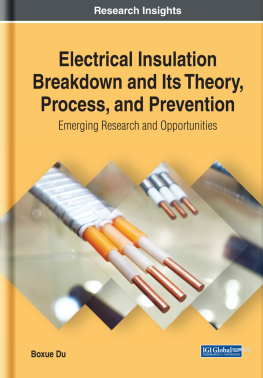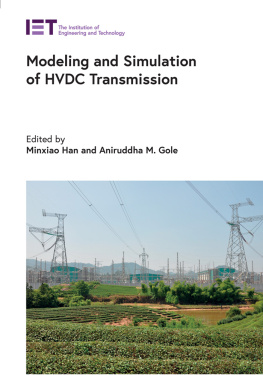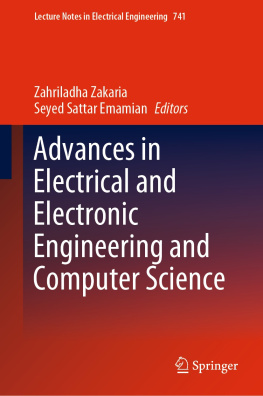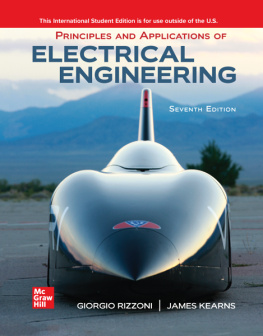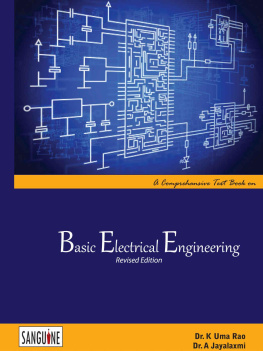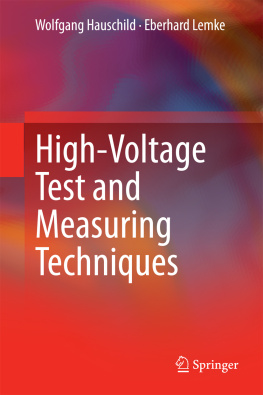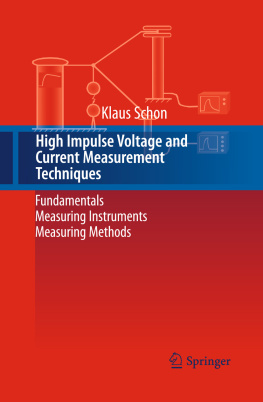Chapter 1
Collection of Breakdown and Discharge Research on Advanced Materials
ABSTRACT
Epoxy resins are widely used to build insulators in GIL. Epoxy/AlN nanocomposite can be produced by adding AlN nanoparticals to the epoxy resin. By studying the surface discharge behavior of the nanocomposites under different operating temperature, it is helpful to improve the creeping voltage of epoxy resin. Polypropylene is a kind of material which is usually chosen to build film capacitors. The effects of voltage form on surface charge and discharge behavior were studied. Furthermore, a modification method of a polypropylene film which can suppress surface charge accumulation is proposed. Polypropylene also has great application potential in HVDC cable insulation, provided that its toughness is to be overcome. Different mass fractions of ULDPE and graphene were added to polypropylen to improve mechanical and insulating properties, respectively. Studies on the DC conductivity, space charge behavior, trap level distribution, and breakdown strength of the new material were carried out.
INTRODUCTION
In the fields of urban power supply and electrical power delivery, high-voltage direct current (HVDC) transmission is widely used (Du, 2017). The advantages of gas insulated transmission line (GIL) include small footprint, high operational reliability and environmental friendliness compared to overhead lines (Zhang, 2017). An epoxy resin is used to make an insulator therein in a gas insulated pipeline transmission system. At DC voltage, the voltage distribution across the insulator depends on the distribution of its conductivity. When overload operation or partial discharge occurs, the operating temperature of the insulator rises, which causes a decrease in insulation performance of the insulator (Du, 2013). During the operation of gas insulated pipelines, creeping discharge is a serious problem. Compared with pure gas breakdown or breakdown of insulating material body, the voltage of creeping discharge is lower, and one of the important reasons for flashover occurs is surface charge concentration (Shao, 2017). The concentration and dissipation behavior of surface charge is affected and decided by the trap distribution characteristics in the materials. At the same time, related research shows that the flashover characteristics of the surface are also closely related to the charge trap (Li, 2010). Therefore, studying the dielectric behavior of epoxy resin under temperature rise is of great significance for improving the operational reliability of gas insulated transmission pipelines. With the development of nanotechnology, many scholars have studied the charge and discharge behavior of epoxy nanocomposites. Studies have found that the insulation properties of materials at higher temperatures are worse than at room temperature (Du, 2016). As the temperature increases, the charge dissipates faster and the traps are deeper and less (Du, 2017). Properly adding nanoparticles helps introduce new traps to capture free charges to achieve the effect of increasing the flashover voltage. However, what will happen if adding nanoparticles and under high temperature environments to the surface charge and flashover behavior of materials remains unknown. Aluminum nitride nanoparticles, a kind of material having high thermal conductivity and low dielectric constant at the same time, were selected as representative particles to be added to the epoxy resin. The effect of adding nanoparticles and different ambient temperature on the surface charge behavior and trap distribution of epoxy resin was studied by surface potential decay method, and then the flashover characteristics of epoxy nanocomposites were studied under the same environment. Through this research, it is helpful to find a suitable formula to improve the creeping voltage of the epoxy resin in different working temperature environments.
Film capacitors widely used in flexible DC transmission systems have excellent self-healing properties, corrosion resistance and low inductance. A film capacitor for a voltage source converter (VSC) is subjected to a DC voltage under normal operating conditions, but a transient overvoltage caused by a power system fault will act on the capacitor (Florentzou, 2009). In this case, the creeping flash in the film capacitor will be caused by the combined voltage of DC and pulse. The electrodes of the film capacitor are divided into small portions which are connected by a fusion bridge. If a local failure occurs, the bridge will melt and isolate the faulty part (Grafton, 2001). Flashover in film capacitors is one of the main causes of failure (Hole, 2001). A composite voltage consisting of a direct current and a pulse voltage causes an increased likelihood of flashover between the electrodes. Compared with other polymer films, polypropylene films are widely used to make film capacitors due to their low breakdown resistance, low dielectric loss factor, and ease of processing (Tsunoda, 2000). The electrical properties of the polypropylene film directly determine the reliability of the film capacitor. The trap in the polymer dielectric can capture charge under voltage, and the application of voltage over a long period of time will cause charge accumulation on the surface of the material (Wang, 2004). The presence of surface charge can cause localized non-uniformities in the electric field distribution, accelerating the electrical aging of the polymer and causing flashover (Kumara, 2012). The surface charge behavior becomes more complicated under the action of a composite voltage consisting of DC and pulse voltage. The accumulation of surface charge affects the flashover voltage along the surface. Therefore, it is important to study the development of flashover of polymer insulation under the action of surface charge on the safety and stability of film capacitors, the concentration distribution of surface charge suppression and the improvement of electric strength. Many scholars have studied the surface charge inhibition mechanism of dielectric polymers. Studies have shown that direct fluorination can optimize the surface state of the polymer and is an effective surface modification method that can change the surface charge accumulation characteristics. The formation of c-f bonds in the surface molecules of the polymer directly affects the dynamic properties of the charge on the surface and inside of the material. In order to suppress the accumulation of surface charge, it is necessary to grasp the charge transport law of the polymer. Carrier mobility is one of the important parameters of charge behavior and is closely related to charge transport. The carrier mobility of the polymer can be obtained by observing the electrical parameters exhibited in the dynamic process of the surface charge, and the experiment is simple and convenient to measure.
Polypropylene (PP), which has attracted much attention in the field of high voltage DC cable insulation research, has excellent dielectric properties and no cross-linking and high temperature resistance (Huang, 2017). However, in further practical applications, the main disadvantage of the inherent brittleness of PP must first be overcome. In response to this shortcoming, related research proposes blending PP with a thermoplastic elastomer, which is an effective means to effectively improve the mechanical properties of polypropylene (Green, 2015). In recent years, it has been found that the addition of ultra low density polyethylene (ULDPE) to rigid substrates is also a means of improving the mechanical properties of materials (Khare, 2000), which can be used to improve the mechanical properties of PP cable insulation. The space charge accumulation behavior under the strong DC electric field is still an important issue to be considered in the research of high-voltage DC cable polymer insulation. The accumulation of charge causes electric field distortion, accelerates insulation aging, and even leads to insulation breakdown failure (Du, 2017; Montanari, 2011). A large amount of research work shows that the doping of nanoparticles can inhibit the accumulation of space charge in the polymer insulation layer, because the interface region between the nano-filler and the polymer dielectric can prevent the movement of free charges and limit the migration of charge carriers., thereby suppressing the injection and transport of space charges (Tanaka, 2005; Li, 2015). Generally speaking, ordinary nano-fillers are theoretically difficult to obtain a large specific surface area. In order to achieve the desired effect, it is necessary to dope a large amount of nano-filler, which causes the particles to agglomerate and even cause concentration defects in the matrix. In recent years, graphene nanoplates and graphene-based composite materials having a special structure of a single atom thick layer and having a large specific surface area have been widely concerned. A small amount of graphene nanoplates can form a large number of interaction zones in the polymer, which is beneficial to further develop the potential of nano-dielectrics. Studies have found that the introduction of graphene brings many deep traps to polyethylene, inhibiting the accumulation of space charge. Studying the insulation properties of polypropylene composites with a small amount of graphene nanoplates will facilitate the development of high voltage DC cable insulation.

